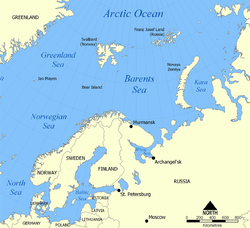| Convoy PQ 4 | |||||||
|---|---|---|---|---|---|---|---|
| Part of Arctic Convoys of the Second World War | |||||||
 The Norwegian and the Barents seas, site of the Arctic convoys | |||||||
| |||||||
| Belligerents | |||||||
Convoy PQ 4 was the fifth of the Arctic Convoys of World War II by which the Western Allies supplied material aid to the Soviet Union in its fight with Nazi Germany. The Convoy sailed from Hvalfjord, Iceland on 17 November 1941 and arrived at Arkhangelsk on 28 November 1941.
